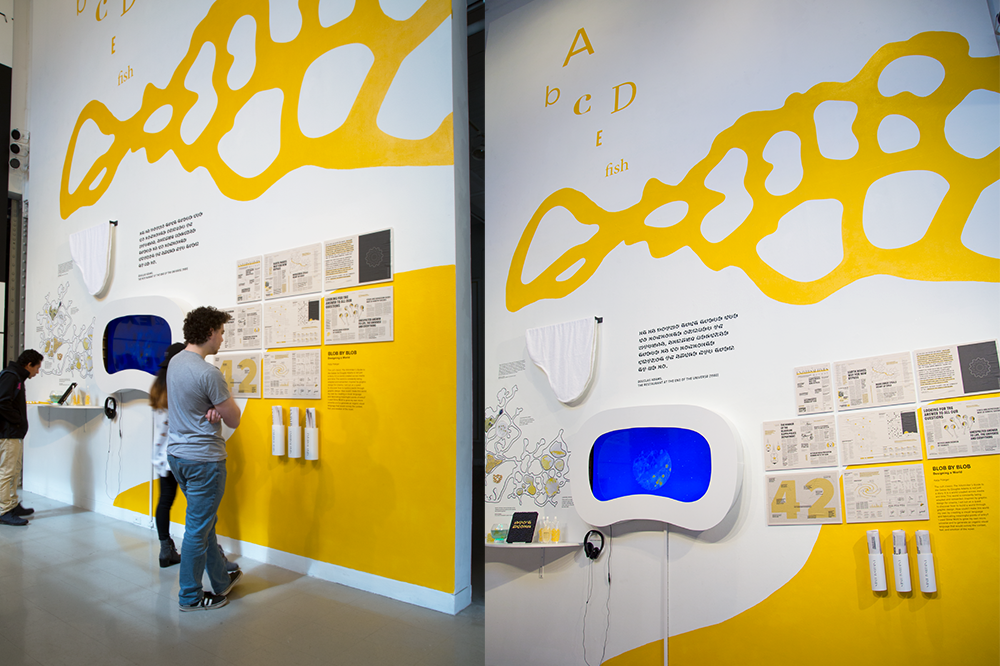Blob by Blob: Designing a World
Katja Flükiger
The cult classic The Hitchhiker’s Guide to the Galaxy by Douglas Adams is not just a story. It is a world created across media and time. This world is constantly being adapted and reinvented. Inspired by graphic design for cinema, I set out on a quest to discover how to build a world through graphic design. How could I make this world my own by creating a visual language and fabricating meaningful points of entry? I used Slime Mold to grow my own micro universe and to generate an organic visual language that would convey the context, feel, and emotion of the novel.

My World
I concentrated on creating a cohesive world with enough points of entry to be accessible even for those who are not familiar with the novel.

The world I chose for my thesis is the world of The Hitchhikers Guide to the Galaxy by Douglas Adams. It is a world that spans over 8 Novels, a radio show, comic books, A movie and multiple stage shows, video games and LP adaptions. The novel itself has been translated into 38 languages. Adams himself was involved in many of these adaptions and reserved himself the liberty to change and adapt the story as he saw fit.

Process Wall
Adams was not necessarily a good story teller but he was a really good world builder. Instead of creating a world around his stories he created stories that would fit into his world.

The Hitchhiker’s Guide Cover
“The Hitchhiker’s Guide has already supplanted the great Encyclopedia Galactica as the standard repository of all knowledge and wisdom, for though it has many omissions and contains much that is apocryphal, or at least wildly inaccurate, it scores over the older, more pedestrian work in two important respects.First, it is slightly cheaper; and secondly it has the words Don’t Panic inscribed in large friendly letters on its cover.”
Douglas Adams, The Hitchhiker’s Guide to the Galaxy (1978)

The Pan Galactic Gargle Blaster
“The Hitchhiker’s Guide to the Galaxy also mentions alcohol. It says that the best drink in existence is the Pan Galactic Gargle Blaster. It says that the effect of a Pan Galactic Gargle Blaster is like having your brains smashed out by a slice of lemon wrapped round a large gold brick.”
Douglas Adams, The Hitchhiker’s Guide to the Galaxy (1978)

Babel Fish
“The Babel fish, is small, yellow and leech-like, and probably the oddest thing in the Universe. If you stick a Babel fish in our ear you can instantly understand anything said to you in any form of language. The speech patterns you actually hear decode the brainwave matrix which has been fed into your mind by your Babel fish.
Douglas Adams, The Hitchhiker’s Guide to the Galaxy (1978)



The Universal Times
The Universal Times is a non-linear attempt at approaching the narrative through the context, the world of the novel.

By removing the element of linearity and time I was able to take apart the hierarchy of the narrative. If read in a linear fashion the story slowly reveals itself to the reader but the sequence of events stays hidden.



Travelling Through Space
To communicate the feeling of movement I wanted to create a window into space. I used timelapses of Slime Mold to create the planets.

Slime Mold
Slime Mold also known as “many headed slime is a eukaryotic organism that can live freely as single cells, but can aggregate together to form a seemingly smart super organism. It is sensitive to light, yellow in color and absolutely loves oats.

Finding the Babel Fish
Many of the forms used to create the visual language I found in close-up photographs or in the movement of Slime Mold.

Optimizing my Process
I spent a lot of time experimenting with the Mold to solidify my approach.

Blobface
I wanted to create a language that is a perfect balance between weird and familiar.

Finding Blobface
Once i started looking for forms, I couldn’t stop.

Mural Experiments

Thank You
I want to thank everyone who has helped me in any shape or form during this crazy journey. I especially want to thank Ellen, Jason, Jennifer and Lindsay for their expert guidance, Matty for being my left and right hand man, Aurora for always listening to me complain, Potch for teaching me his typographic wisdom, Hayeling for helping me to put it all together and the whole MICA GD MFA ‘18 class for sharing their ideas, values and constructive feedback.
